- Author Matthew Elmers [email protected].
- Public 2023-12-16 21:49.
- Last modified 2025-01-24 09:17.
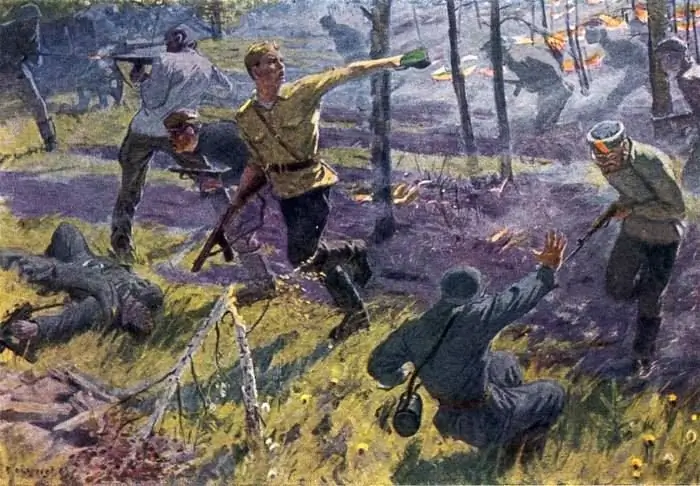
The entry of Soviet troops into the territory of Belarus in the fall of 1943, their exit to the basing areas of large partisan groups, to the partisan edges and zones, immediately affected the tactics of the partisans. The Belarusian headquarters of the partisan movement (BShPD), planning the actions of partisan formations, began to take more concrete into account the tasks that had to be solved in the interests of the advancing troops. Partisan detachments and formations were supposed to provide not only reconnaissance, the destruction of enemy communications, but also direct interaction with units of the Red Army on the battlefield, including assisting in the capture of advantageous lines, strongholds, nodes of resistance, crossings and bridgeheads, the liberation of populated points. The partisans solved all this in a complex. The seizure of bridges and crossings on the water lines by them, holding them until the approach of the advancing troops is part of a single process of fighting the fascists. The success and effectiveness of interaction between the partisan detachments and the advancing troops were largely facilitated by the well-organized centralized leadership of the partisan movement by the Central Assault Command, the BSPD, front and army headquarters, as well as the rich experience gained by the partisans in previous battles in the enemy rear.
Let us consider the actions of the partisans, dividing them into two stages: the first - the liberation of the eastern regions of Belarus, first in the fall of 1943 to May 1944, the second - in Operation Bagration (June - August 1944). When preparing operations in the fall and winter of 1943 (Nevelskaya, Gomel-Rechitskaya, etc.), the front and army headquarters, through the operational representatives of the BSHPD, set specific tasks for the partisan formations operating in the zones of their offensive, to conduct reconnaissance, sabotage German communications, to seize and retention of ferries. The last problem was solved in various ways. The detachments captured bridgeheads, bridges, ferry crossings, fords on the rivers and held them until the approach of Soviet troops. When such an opportunity did not appear, the partisans took up defenses on one or both banks of the river, equipped a crossing there, concentrated boats and other improvised means, or held bridgeheads on the rivers, thereby making it easier for the troops to cross water barriers.
For example, during the Nevelskoy operation, detachments of the Vitebsk partisans on November 2, 1943, captured a number of German strongholds on the Drissa and Sinsha rivers and built ferries. Partisan scouts were sent to meet the 4th Shock Army. They met in the Dudchino area the advanced units of the 219th Rifle Division and led them to the crossings. The advancing units did not have to cross these rivers with battles, they quickly crossed them over the bridges built by the partisans. During the Gomel-Rechitsa operation, the troops of the Central Front also closely interacted with the Belarusian partisans. On the instructions of the command, the Gomel partisans struck a series of blows at the retreating enemy troops, captured and held several crossings. The Gomel partisan unit of the commander IP Kozhar was especially distinguished in these battles. The partisans of the formation continuously carried out sabotage in the rear, made daring raids on the headquarters, warehouses and communication centers of the enemy, in the Beregovaya Sloboda region they blew up the enemy crossing. On November 19, they captured 34 settlements on the western bank of the Dnieper and held them until units of the 19th rifle corps approached.
Under the control of the partisans of Belarus, they took many crossings and bridges, blocked the railways and did not allow the Nazis to transfer reserves from Minsk and Brest to the Gomel direction. Partisans of the Belarusian Polesye, formations of Gomel and Minsk partisans took part in the unfolding battles. Thus, the Bolshevik brigade (commander IF Gamarko) of the Gomel formation of the BShPD partisans set the task to prevent the planned withdrawal of the German troops by all means. The partisans made blockages on the road, dug an anti-tank ditch, trenches, mined tank-hazardous areas from the village of Beregovaya Sloboda to the town of Gorval. For three days they held the approaches to the Berezina River, and the Nazis could not break through in this area.
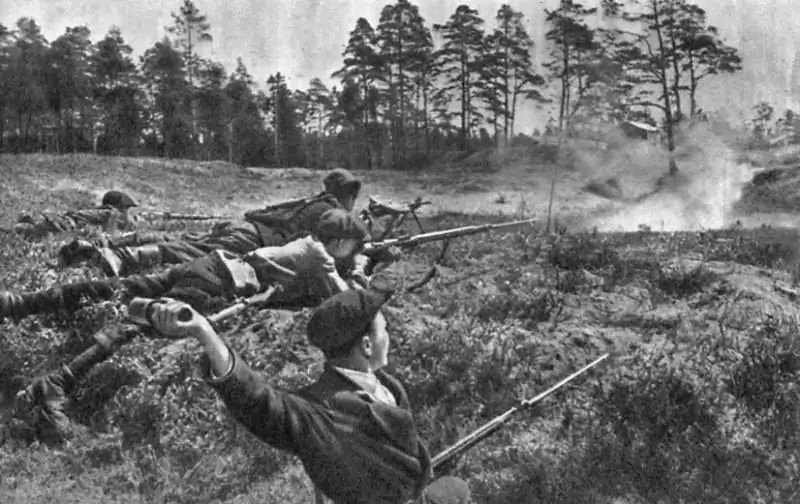
To deliver stronger and more effective strikes against the enemy, the headquarters of the Gomel formation decided to combine a number of brigades and detachments into one group. V. I. Sharudo, Commissioner E. G. Sadovoy. The group was ordered to saddle the Gorvalsky Way and not give the Nazis the opportunity to cross to the left bank of the Berezina.
At dawn on November 18, three detachments of the group secretly approached the outskirts of Gorval and shouted "Hurray!" unexpectedly rushed to the fascists. The enemy rushed to the river in panic, but only a few managed to reach the opposite bank. On November 19, under cover of artillery fire, the Germans unsuccessfully tried to drive the partisans out of the village. In the evening, the advance units of the 37th Guards approached Gorval. rifle division of Major General E. G. Ushakov - a battalion of machine gunners. By the joint efforts of the soldiers and partisans, Gorval was completely liberated from the Germans. The crossing of the fascist troops across the Berezina was disrupted.
Partisan detachments I. G. Borunov and G. I. Sinyakov successfully interacted with units of the 55th Infantry Division of the 61st Army. So, on November 22, when the 111th Infantry Regiment reached the Braginka River, the partisans, with the onset of darkness, struck the Nazis from the rear and helped the Red Army units to quickly force the river and capture the Bragin regional center.
During the preparation and conduct of the Mozyr-Kalinkovichi operation, the Polissya partisans, by order of the BSHPD, established close cooperation with units of the 61st Army. At the end of 1943, the commanders of the Mozyr, Narovlyansk and Yelsk partisan brigades contacted the commanders of the 2nd (Lieutenant General V. V. Kryukov), 7th (Major General M. P. Konstantinov) Guards Cavalry Corps. The partisans helped the cavalry units to cross the Pripyat River at night and led them through the forests to the rear of the enemy. Concentration was concealed from the enemy. The German command did not expect that the Soviet troops could imperceptibly overcome the river and impassable swamps and go deep into their rear.
The blow from the front and rear was overwhelming for the enemy. As a result of a skillfully carried out bypass maneuver, units of the 61st Army, interacting with the neighboring 65th Army and with the support of the forces of partisan detachments, on the night of January 14, 1944, broke into Mozyr in battle and captured it. In addition, a group of partisans under the command of A. D. Kolos was blown up by the railway bridge on the Ippa River, which blocked the Nazis' escape route to the west.
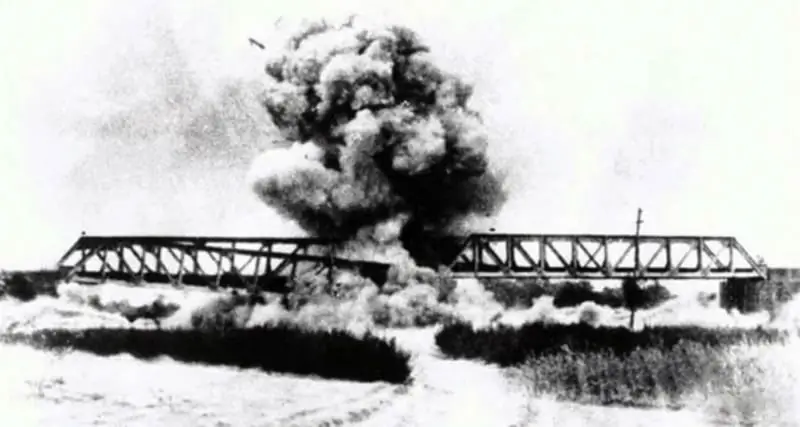
The BSHPD paid much attention to reconnaissance of the German defense on the water lines. So, long before the start of the offensive operation of our troops, back on February 21, 1944, the operational group of the BShPD on the Western Front assigned specific tasks to the partisan formations. Partisan regiment I. F. Sadchikov received the task of conducting reconnaissance of the state of the enemy defensive line in a number of areas along the Western Dvina River, the brigade of S. N. Narchuk - along the Dnieper River, G. A. Brick - along the Berezina river, brigade Z. P. Gaponov - along the Dnieper and Drut 'rivers, S. V. Grishin's regiment - along the Dnieper, Berezina, Lokhva, Drut', Olsa rivers. Similar tasks were given to the Baltic and Byelorussian fronts.
Fulfilling the missions of the BSHPD, the partisans launched extensive reconnaissance activities and provided the front command with very valuable information about the state of the defensive lines built by the Nazis on the water lines, about the presence and nature of river crossings in the enemy's rear. So, on March 1, 1944, the military-operational group at the Shklov underground RK CP (b) reported to the headquarters of the Western Front information about enemy fortifications on the Dnieper River and about the presence of crossings here. Detailed intelligence information about the enemy came from the partisans to the headquarters of the fronts even before the start of the Soviet offensive operation. Thus, the headquarters of the 2nd Belorussian Front during April-May 1944 regularly received intelligence from the partisans about the state of the enemy's defensive structures along the western banks of the Mereya, Pronya, Basia, Resta, Dnieper and Drut rivers in the Mogilev direction. All information received from the partisans was carefully studied, compared with other intelligence data and used in planning and during the operation.
Proceeding from the orders of the Central Committee of the All-Union Communist Party (Bolsheviks), the Supreme Command Headquarters, the Central Committee of the Communist Party (Bolsheviks), and the BSHPD (Chief of Staff P. Z. fronts. The formations of the partisans of the Vitebsk, Vileika, northern parts of the Minsk and Baranovichi regions, in particular, had to strike at the most important fascist communications, hold the bridgehead occupied on the Berezina River until the approach of the Red Army units, ensuring the offensive of the 1st Baltic and 3rd Belorussian fronts. Partisan formations of the Mogilev region, brigades stationed in the east of the Minsk region, were supposed to provide support to the troops of the 2nd Belorussian Front crossing the Dnieper. The Polesie, Yuzhno-Minsk, Pinsk and Belostok partisans were given the task of creating suitable conditions for the deployment of an offensive by the forces of the 1st Belorussian Front.
All the tasks assigned to the partisan formations were successfully completed. So, in the zone of operations of the 28th Army, already on the fourth day of the offensive operation, four brigades of the Minsk partisan formation (commander V. I. and helped parts of the 48th Guards. rifle division to cross the Ptich River.
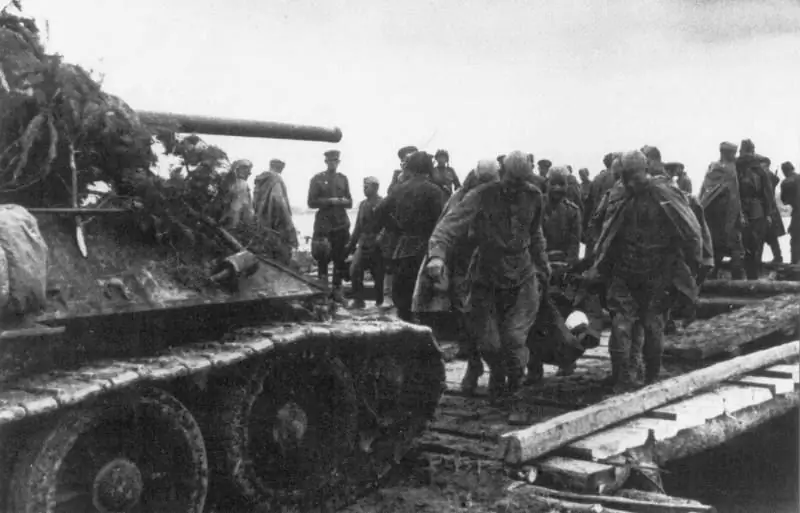
During June 26-28, partisan brigades of the Belarusian Polesie, commanded by I. M. Kulikovsky, V. Z. Putyato, I. M. Kulikovsky N. D. Kuranov, I. N. Merzlyakov, M. A. Volkov and others. The combat operations of five partisan brigades to seize the crossings on the Sluch River in the Starobin-Slutsk region were coordinated by a representative of the 37th Guards Brigade. Rifle Division of the 65th Army Major B. M. Devil.
37th partisan brigade named after Parkhomenko (commander A. V. Lvov) and the 64th Chkalov Brigade (commander N. N. Taking advantage of the crossings captured by the partisans, the troops of the 28th Army continued to pursue the enemy on a wide front and, together with the partisans, smashed his scattered groups. The river crossings on the Ptich river between Kholopenichi and Porechye were captured by the 161st partisan brigade (commander A. S. Shashura), and units of the 20th rifle corps took advantage of them.
In the zone of operations of the 2nd Belorussian Front, bridges and crossings were seized by Mogilev partisans. So, the 61st partisan detachment (commander G. K. Pavlov), for seven hours on June 27, fought a heavy battle for the crossing on the Drut 'river, near the village of Gorodishche, Mogilev region. The partisans held the crossing and handed it over to the approaching units of the 238th Infantry Division. The success of the hostilities aimed at capturing water lines was facilitated by a thorough preliminary reconnaissance of river fords and crossings.
Partisans of the Begoml brigade "Zheleznyak" (commander IF Titkov), captured and held the crossings across the Berezina. With the approach of the 35th Guards. tank brigade, they built two bridges over which the tankers were able to cross to the opposite bank. After that, the partisans, in the role of a tank landing, liberated Dokshchitsy, Dolginovo and the Parafyanovo railway junction.
In addition to capturing bridges and crossings and transferring them to the advanced units of the Red Army, partisans and local residents made a lot of efforts to restore the bridges and crossings destroyed by the Germans, and to build new ones. So, the brigade "Chekist" (commander GA Kirpich) built 5 bridges on the Mozha River near the village of Ukhvaly for the 2nd Guards. tank corps. Smolensk partisan regiment I. F. Sadchikov, after joining on July 2 with units of the 1st Baltic Front on the Viliya River, helped the 1st Tank Corps to restore four crossings and two destroyed bridges. The partisans also reported important information about the enemy defense along the Viliya River. The partisans of the 16th Smolensk brigade N. G. Shlapakov. Under enemy bombs, the 2nd, 4th and 6th detachments of the brigade persistently rebuilt the bridge near the village of Mikhalishki. The partisans performed the task perfectly. Having liberated the town of Svir on July 4, they held a bridge over the river here until the approach of Soviet troops.
Partisans of the western regions of the republic also actively participated in the liberation of Belarus. So, partisans of the Baranovichi formation (commander V. E. Chernyshov), on the instructions of the Soviet command, thwarted the attempts of the invaders to gain a foothold on the Neman River. The 1st Belarusian Cavalry Partisan Brigade (commander D. A. Denisenko) took up defenses on the left bank of the Neman on the Eremici-Bykovichi line on July 2. The cavalry guerrillas repelled the attempts of the retreating fascists from near Minsk to cross the Neman and get out on the Turets-Korelichi road for almost the whole day.
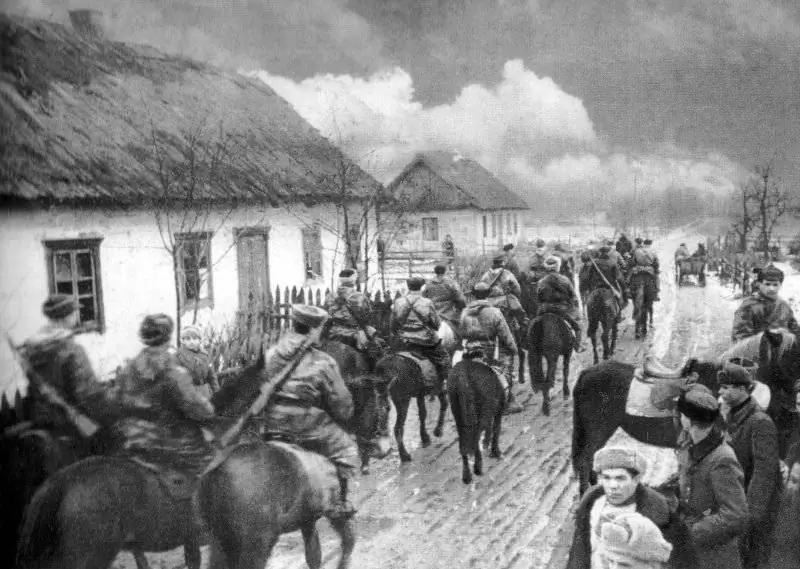
Fulfilling the order of the commander of the 1st mechanized corps, Lieutenant-General S. M. Krivoshein, the Baranovichi partisans captured the bridge over the Shchara river on the Slutsk Brest highway and held it until the corps units approached. The bridge was saved, and our tanks, without delay, quickly moved forward to the west. In the battles in the Baranovichi direction, the partisan brigade named after I. V. Stalin V. A. Tikhomirov. On July 3, in the Zavshitsy-Starchitsy-Krivichi area, the brigade merged with the 3rd Guards. tank corps. The partisans helped the tankers to arrange crossings across the Moroch River, provided the tank columns with guides and scouts to Baranovichi. Being well oriented on the terrain, they led the Soviet troops into the deep enemy rear, conducted reconnaissance of bridges, fords and river crossings, organized the population for the construction and restoration of bridges, crossings, and repair of access roads. The partisans of the Vileika region, for example, built more than three hundred bridges and fifteen crossings over water lines.
After joining the units of the Red Army, partisans and underground workers, with the help of the local population, were restoring destroyed roads and crossings, ensuring the non-stop advance of the advancing units of the Red Army. Only partisans of the 2nd Minsk brigade N. G. Andreeva, with the active help of local residents, erected 39 bridges in three days, dismantled many rubble and filled 75 ditches on the roads. This was done by the partisans of the entire republic, assisting in the quickest offensive of the Red Army to the west.
During the period of the battles for the liberation of Belarus, the partisans worked closely with our advancing troops at the operational and tactical level. The seizure of important lines, bridges and crossings by the partisans behind enemy lines contributed to an increase in the pace of the offensive of the troops, forcing them on the move water obstacles, thwarted the plans of the German command to systematically withdraw troops to the rear defensive lines. With the help of partisans and local residents, Soviet troops almost without any delay crossed such rivers as Berezina, Drut ', Sluch, Ptich, Viliya, Neman, Shchara and many others. The front command highly appreciated the actions of the partisans to seize crossings and bridges during the Bagration operation, pointing out that the partisans were able to significantly paralyze the Nazis' retreat routes, making it difficult to regroup and ensure the supply of troops. With this, the partisans made a significant contribution to the defeat of the German troops in Belarus.






